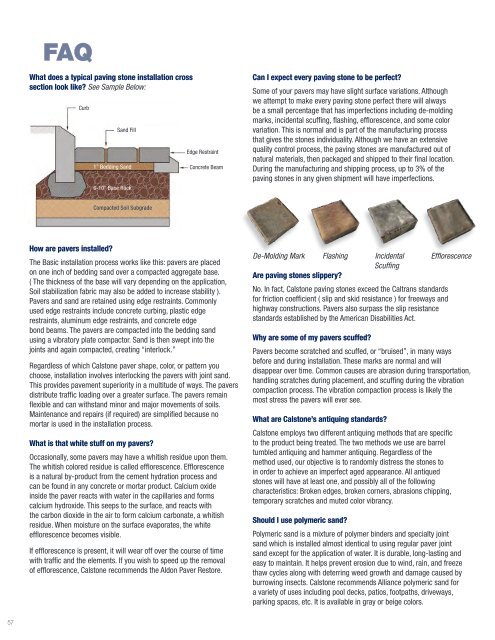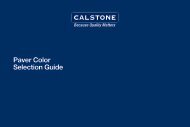Calstone Catalog
Calstone's Hardscape Collection: Paving Stones, Landscape Structures and Retaining Walls.
Calstone's Hardscape Collection: Paving Stones, Landscape Structures and Retaining Walls.
Create successful ePaper yourself
Turn your PDF publications into a flip-book with our unique Google optimized e-Paper software.
FAQ<br />
What does a typical paving stone installation cross<br />
section look like? See Sample Below:<br />
Curb<br />
Sand Fill<br />
1” Bedding Sand<br />
6-10” Base Rock<br />
Edge Restraint<br />
Concrete Beam<br />
Can I expect every paving stone to be perfect?<br />
Some of your pavers may have slight surface variations. Although<br />
we attempt to make every paving stone perfect there will always<br />
be a small percentage that has imperfections including de-molding<br />
marks, incidental scuffing, flashing, efflorescence, and some color<br />
variation. This is normal and is part of the manufacturing process<br />
that gives the stones individuality. Although we have an extensive<br />
quality control process, the paving stones are manufactured out of<br />
natural materials, then packaged and shipped to their final location.<br />
During the manufacturing and shipping process, up to 3% of the<br />
paving stones in any given shipment will have imperfections.<br />
Compacted Soil Subgrade<br />
How are pavers installed?<br />
The Basic installation process works like this: pavers are placed<br />
on one inch of bedding sand over a compacted aggregate base.<br />
( The thickness of the base will vary depending on the application,<br />
Soil stabilization fabric may also be added to increase stability ).<br />
Pavers and sand are retained using edge restraints. Commonly<br />
used edge restraints include concrete curbing, plastic edge<br />
restraints, aluminum edge restraints, and concrete edge<br />
bond beams. The pavers are compacted into the bedding sand<br />
using a vibratory plate compactor. Sand is then swept into the<br />
joints and again compacted, creating “interlock.”<br />
Regardless of which <strong>Calstone</strong> paver shape, color, or pattern you<br />
choose, installation involves interlocking the pavers with joint sand.<br />
This provides pavement superiority in a multitude of ways. The pavers<br />
distribute traffic loading over a greater surface. The pavers remain<br />
flexible and can withstand minor and major movements of soils.<br />
Maintenance and repairs (if required) are simplified because no<br />
mortar is used in the installation process.<br />
What is that white stuff on my pavers?<br />
Occasionally, some pavers may have a whitish residue upon them.<br />
The whitish colored residue is called efflorescence. Efflorescence<br />
is a natural by-product from the cement hydration process and<br />
can be found in any concrete or mortar product. Calcium oxide<br />
inside the paver reacts with water in the capillaries and forms<br />
calcium hydroxide. This seeps to the surface, and reacts with<br />
the carbon dioxide in the air to form calcium carbonate, a whitish<br />
residue. When moisture on the surface evaporates, the white<br />
efflorescence becomes visible.<br />
If efflorescence is present, it will wear off over the course of time<br />
with traffic and the elements. If you wish to speed up the removal<br />
of efflorescence, <strong>Calstone</strong> recommends the Aldon Paver Restore.<br />
De-Molding Mark Flashing Incidental Efflorescence<br />
Scuffing<br />
Are paving stones slippery?<br />
No. In fact, <strong>Calstone</strong> paving stones exceed the Caltrans standards<br />
for friction coefficient ( slip and skid resistance ) for freeways and<br />
highway constructions. Pavers also surpass the slip resistance<br />
standards established by the American Disabilities Act.<br />
Why are some of my pavers scuffed?<br />
Pavers become scratched and scuffed, or “bruised”, in many ways<br />
before and during installation. These marks are normal and will<br />
disappear over time. Common causes are abrasion during transportation,<br />
handling scratches during placement, and scuffing during the vibration<br />
compaction process. The vibration compaction process is likely the<br />
most stress the pavers will ever see.<br />
What are <strong>Calstone</strong>’s antiquing standards?<br />
<strong>Calstone</strong> employs two different antiquing methods that are specific<br />
to the product being treated. The two methods we use are barrel<br />
tumbled antiquing and hammer antiquing. Regardless of the<br />
method used, our objective is to randomly distress the stones to<br />
in order to achieve an imperfect aged appearance. All antiqued<br />
stones will have at least one, and possibly all of the following<br />
characteristics: Broken edges, broken corners, abrasions chipping,<br />
temporary scratches and muted color vibrancy.<br />
Should I use polymeric sand?<br />
Polymeric sand is a mixture of polymer binders and specialty joint<br />
sand which is installed almost identical to using regular paver joint<br />
sand except for the application of water. It is durable, long-lasting and<br />
easy to maintain. It helps prevent erosion due to wind, rain, and freeze<br />
thaw cycles along with deterring weed growth and damage caused by<br />
burrowing insects. <strong>Calstone</strong> recommends Alliance polymeric sand for<br />
a variety of uses including pool decks, patios, footpaths, driveways,<br />
parking spaces, etc. It is available in gray or beige colors.<br />
57




